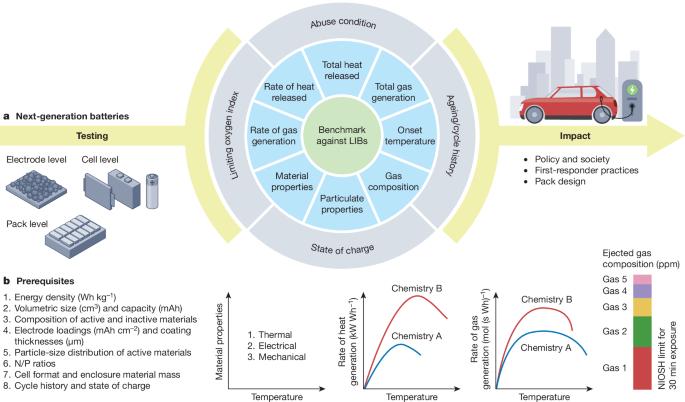解决下一代电池的安全性问题。
IF 48.5
1区 综合性期刊
Q1 MULTIDISCIPLINARY SCIENCES
引用次数: 0
摘要
由于对具有安全材料供应链的低成本能源存储的需求不断增加,电池界正在接近从传统锂离子(Li-ion)向下一代电池的关键转变。包括碱金属阳极、固体电解质和富含土壤的材料(如钠和硫)在内的技术正在电池中实现商业化。这种技术的耐受性和热失控的危险不同于传统的锂离子电池。因此,用下一代材料设计安全的电池需要一种全面的方法来表征电池,并了解它们从使用寿命开始到结束对滥用条件的反应。在这里,我们提供了一个关于细胞的安全性和滥用耐受性如何可能改变新兴技术的观点;重新构想安全电池和电池设计的挑战和机遇;知识上的空白;了解热失控的危险以及如何解决这些危险的能力;标准滥用测试可能需要如何适应新的挑战;以及研究需要如何支持受影响的专业人员,从包装设计师到急救人员,来管理危害,并确保下一代电池在电动汽车(ev)等应用中的安全推广。最后,考虑到大量正在探索的下一代技术,我们鼓励优先考虑以安全为重点的研究,与每种特定技术的生产规模成比例。本文章由计算机程序翻译,如有差异,请以英文原文为准。

Addressing the safety of next-generation batteries
Owing to increasing demand for low-cost energy storage with secure material supply chains, the battery community is approaching a pivotal shift beyond conventional lithium-ion (Li-ion) towards next-generation cells. Technologies that include alkali-metal anodes, solid electrolytes and earth-abundant materials such as sodium (Na) and sulfur (S) are reaching commercialization in cells. The abuse tolerance and thermal runaway hazards of such technologies diverge from conventional Li-ion cells. Consequently, designing safe batteries with next-generation materials requires a holistic approach to characterize cells and to understand their responses to abuse conditions from the beginning to the end of life. Here we provide a Perspective on how the safety and abuse tolerance of cells are likely to change for up-and-coming technologies; challenges and opportunities for reimagining safe cell and battery designs; gaps in our knowledge; capabilities for understanding the hazards of thermal runaway and how to address them; how standard abuse tests may need to adapt to new challenges; and how research needs to support affected professionals, from pack designers to first responders, to manage hazards and ensure safe roll-out of next-generation cells into applications like electric vehicles (EVs). Finally, given the large number of next-generation technologies being explored, we encourage giving priority to safety-focused research in proportion to the rate of manufacturing scale-up of each specific technology. Next-generation batteries will present different risks to conventional lithium-ion cells, emphasizing the need for efforts towards characterizing the abuse tolerance and hazards associated with next-generation battery materials over their life cycle and providing the data in the context of supporting affected professionals.
求助全文
通过发布文献求助,成功后即可免费获取论文全文。
去求助
来源期刊

Nature
综合性期刊-综合性期刊
CiteScore
90.00
自引率
1.20%
发文量
3652
审稿时长
3 months
期刊介绍:
Nature is a prestigious international journal that publishes peer-reviewed research in various scientific and technological fields. The selection of articles is based on criteria such as originality, importance, interdisciplinary relevance, timeliness, accessibility, elegance, and surprising conclusions. In addition to showcasing significant scientific advances, Nature delivers rapid, authoritative, insightful news, and interpretation of current and upcoming trends impacting science, scientists, and the broader public. The journal serves a dual purpose: firstly, to promptly share noteworthy scientific advances and foster discussions among scientists, and secondly, to ensure the swift dissemination of scientific results globally, emphasizing their significance for knowledge, culture, and daily life.
 求助内容:
求助内容: 应助结果提醒方式:
应助结果提醒方式:


